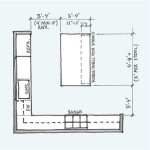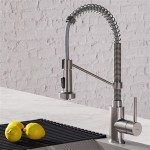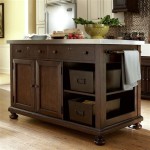Water Filter Faucet: A Kitchen Sink Essential
A water filter faucet integrated into a kitchen sink serves as a crucial component for accessing purified drinking water directly from the tap. These faucets are designed to work in conjunction with an under-sink water filtration system, providing a dedicated pathway for filtered water while maintaining the regular functionality of the main kitchen faucet. The integration of such a system leads to improved water quality, convenience, and reduced reliance on bottled water.
The core function of a water filter faucet is to dispense water that has undergone a filtration process, removing contaminants and impurities that may be present in the municipal water supply or well water. These contaminants can include sediment, chlorine, lead, bacteria, and other potentially harmful substances. The filtration system typically connects to the cold water line under the sink, processing the water before it reaches the dedicated filter faucet. This ensures that only purified water is dispensed from the filter faucet, while the main kitchen faucet continues to provide unfiltered hot and cold water for other household tasks, such as washing dishes or cleaning.
Water filter faucets are available in a variety of styles, finishes, and designs to complement different kitchen aesthetics. They are typically smaller and more streamlined compared to standard kitchen faucets, often featuring a single handle or lever for easy operation. The construction materials used in these faucets are selected for durability and resistance to corrosion, ensuring a long lifespan and consistent performance. Common materials include stainless steel, brass, and chrome, each offering varying degrees of aesthetic appeal and resistance to wear and tear.
The installation process for a water filter faucet generally involves connecting it to the outlet of an under-sink water filtration system. This requires basic plumbing skills and tools, although professional installation is often recommended to ensure proper connection and prevent leaks. The process typically involves drilling a small hole in the countertop or sink to accommodate the faucet shank, connecting the water lines, and securing the faucet in place. Clear and concise instructions are usually included with the faucet and filtration system to guide the installation process.
Benefits of Using a Water Filter Faucet
One of the primary advantages of using a water filter faucet is the improved taste and odor of the water. Filtration systems effectively remove chlorine and other chemicals that contribute to unpleasant tastes and smells. This results in water that is more palatable and enjoyable to drink. Consistent access to clean, good-tasting water encourages increased hydration, which is crucial for overall health and well-being.
Another significant benefit is the reduction in harmful contaminants. Many water filtration systems are designed to remove or significantly reduce the presence of lead, bacteria, cysts, and other potentially dangerous substances. This is particularly important for individuals with compromised immune systems, young children, and pregnant women, who are more susceptible to the negative effects of waterborne contaminants. By using a water filter faucet, households can minimize the risk of exposure to these harmful substances and improve the overall safety of their drinking water.
Furthermore, using a water filter faucet offers a more sustainable and cost-effective alternative to bottled water. The reliance on bottled water contributes to plastic waste and environmental pollution. By filtering tap water at home, households can significantly reduce their consumption of bottled water, minimizing their environmental impact and saving money in the long run. The initial investment in a water filtration system and faucet is often offset by the savings on bottled water purchases over time.
Different Types of Water Filtration Systems
Various types of water filtration systems can be used in conjunction with a water filter faucet, each offering different levels of filtration and addressing specific water quality concerns. The choice of filtration system depends on the specific contaminants present in the water supply and the desired level of purification. Some of the most common types of water filtration systems include activated carbon filters, reverse osmosis (RO) systems, and ultraviolet (UV) disinfection systems.
Activated carbon filters are widely used for removing chlorine, sediment, volatile organic compounds (VOCs), and other impurities that affect the taste and odor of water. These filters work by adsorbing contaminants onto the surface of activated carbon particles, effectively trapping them and preventing them from passing through to the filtered water. Activated carbon filters are relatively inexpensive and easy to maintain, making them a popular choice for general water purification. They are available in various forms, including granular activated carbon (GAC) and carbon block filters, each offering different levels of filtration efficiency.
Reverse osmosis (RO) systems are more advanced filtration systems that use a semi-permeable membrane to remove a wider range of contaminants, including dissolved solids, heavy metals, and microorganisms. RO systems work by forcing water through the membrane, leaving behind contaminants that are then flushed away. RO systems are highly effective at producing purified water, but they also tend to waste some water in the process. They typically require more space and maintenance compared to activated carbon filters and are generally more expensive.
Ultraviolet (UV) disinfection systems use ultraviolet light to kill bacteria, viruses, and other microorganisms that may be present in the water. UV systems do not remove sediment or chemicals, but they are highly effective at disinfecting water and making it safe to drink. UV systems are often used in conjunction with other filtration methods, such as activated carbon filters, to provide comprehensive water purification. They require a power source to operate and typically have a UV lamp that needs to be replaced periodically.
Factors to Consider When Choosing a Water Filter Faucet
Selecting the right water filter faucet involves considering several factors, including the desired style and finish, the compatibility with the chosen filtration system, the flow rate, and the ease of installation and maintenance. It's also important to consider the overall budget and the long-term cost of filter replacements.
The aesthetic appeal of the faucet is an important consideration for many homeowners. Water filter faucets are available in a variety of styles and finishes to match existing kitchen fixtures and décor. Common finishes include stainless steel, chrome, brushed nickel, and oil-rubbed bronze. The style of the faucet should complement the overall design of the kitchen and reflect the homeowner's personal preferences.
Compatibility with the chosen filtration system is crucial. The faucet must be compatible with the outlet size and type of the filtration system. It's important to ensure that the faucet can handle the water pressure and flow rate produced by the filtration system. Some filtration systems require specific types of faucets, so it's essential to consult the manufacturer's specifications before making a purchase.
The flow rate of the faucet is also an important consideration. A higher flow rate means that water will be dispensed more quickly, which can be convenient for filling large pitchers or pots. However, a higher flow rate may also mean that the filtration system has to work harder, potentially reducing the lifespan of the filter. It's important to find a balance between flow rate and filtration efficiency.
Ease of installation and maintenance is another factor to consider. Some water filter faucets are easier to install than others, and some require more maintenance. It's important to choose a faucet that is relatively easy to install and maintain, or to hire a professional plumber to handle the installation. Regular maintenance, such as replacing filters, is essential for ensuring optimal performance and water quality.
Finally, it's important to consider the overall budget and the long-term cost of filter replacements. Water filter faucets range in price from relatively inexpensive to quite expensive, depending on the style, finish, and features. It's also important to factor in the cost of replacement filters, which can vary depending on the type of filtration system. By considering all of these factors, homeowners can choose a water filter faucet that meets their needs and budget.
In summary, a water filter faucet serves as a convenient and effective means of accessing purified drinking water directly from the kitchen sink. It works in conjunction with an under-sink water filtration system to remove contaminants and impurities, improving the taste, odor, and safety of the water. By considering the various types of filtration systems, faucet styles, and factors involved in installation and maintenance, homeowners can make an informed decision and enjoy the many benefits of having a water filter faucet in their kitchen.

1 4 Inch Sink Water Purifier Tap Kitchen Faucet Filter Drink System Ebay
Kitchen Faucet Spray Pull Out Tap Twin Double Pipe Purifier Ro Water Filter 3 Function Hot Cold Mixer Sink Shopee Singapore

Express Water Modern Chrome Filter Faucet Drinking Reverse Osmosis Filtration System And Kitchen Sink Beverage Simple
In Stock Store Water Filter Faucet Stainless Steel Reverse Osmosis Rotatable 1 4 Inch Touch Control Sink Tap Kitchen Accessories

What Are Kitchen Faucet Filters And Do They Really Work Culligan

Lead Free Stainless Steel Ro Drinking Water Filter Dispenser Kitchen Sink Purifier Faucet For Household Tap Mixer Made In Com

Sink Water Purifier Tap Kitchen Faucet Filter 1 4 Inch Drink System Ebay

Is Under Sink Water Filter A Good Choice For You

Stainless Steel Kitchen Water Filter Faucet Reverse Osmosis Drinking Sink Tap

Mrb Kitchen 1 4 Inch Ro Drinking Water Filter Faucet Reverse Osmosis System Sink Tap Lazada Singapore
See Also








